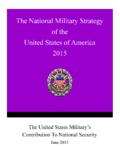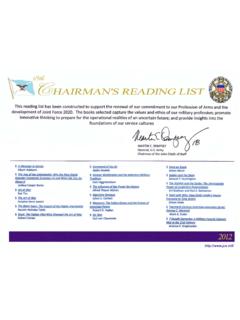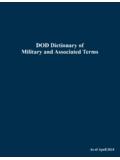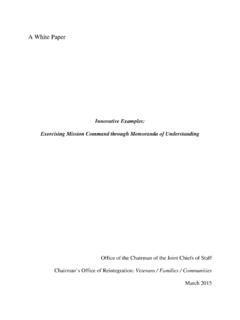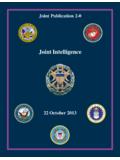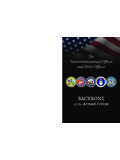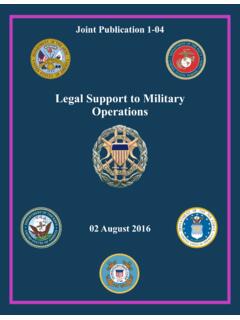Transcription of JP 3-0, Joint Operations, 17 January 2017, Incorporating ...
1 Joint Publication 3-0. T OF T H. EN E. TM HI. S W E' L L. DE. FE. T. ND. AR. AR. DE P. MY.. I CA. U NI. ER. TE. M. D. ST A. AT E S O F. Joint operations 17 january 2017 . Incorporating Change 1. 22 October 2018. PREFACE. 1. Scope This publication is the keystone document of the Joint operations series. It provides the doctrinal foundation and fundamental principles that guide the Armed Forces of the United States in all Joint operations . 2. Purpose This publication has been prepared under the direction of the Chairman of the Joint Chiefs of Staff. It sets forth Joint doctrine to govern the activities and performance of the Armed Forces of the United States in Joint operations , and it provides considerations for military interaction with governmental and nongovernmental agencies, multinational forces, and other interorganizational partners.
2 It provides military guidance for the exercise of authority by combatant commanders and other Joint force commanders (JFCs), and prescribes Joint doctrine for operations and training. It provides military guidance for use by the Armed Forces in preparing and executing their plans and orders. It is not the intent of this publication to restrict the authority of the JFC from organizing the force and executing the mission in a manner the JFC deems most appropriate to ensure unity of effort in the accomplishment of objectives. 3. Application a. Joint doctrine established in this publication applies to the Joint Staff, commanders of combatant commands, subordinate unified commands, Joint task forces, subordinate components of these commands, the Services, and combat support agencies.
3 B. The guidance in this publication is authoritative; as such, this doctrine will be followed except when, in the judgment of the commander, exceptional circumstances dictate otherwise. If conflicts arise between the contents of this publication and the contents of Service publications, this publication will take precedence unless the Chairman of the Joint Chiefs of Staff, normally in coordination with the other members of the Joint Chiefs of Staff, has provided more current and specific guidance. Commanders of forces operating as part of a multinational (alliance or coalition) military command should follow multinational doctrine and procedures ratified by the United States.
4 For doctrine and procedures not ratified by the US, commanders should evaluate and follow the multinational command's doctrine and procedures, where applicable and consistent with US law, regulations, and doctrine. For the Chairman of the Joint Chiefs of Staff: KEVIN D. SCOTT. Vice Admiral, USN. Director, Joint Force Development i Preface Intentionally Blank ii JP 3-0 CH 1. SUMMARY OF CHANGES. REVISION OF Joint PUBLICATION 3-0. DATED 17 january 2017 . Revises Chapter V, Joint operations Across the Conflict Continuum, to expand the discussion of the changing balance of military activities in different types of military operations . Distributes pertinent information from Chapter V, Joint operations Across the Conflict Continuum, into Chapters VI, Military Engagement, Security Cooperation, and Deterrence, VII, Crisis Response and Limited Contingency operations , and VIII, Large-Scale Combat operations to enhance readability.
5 Clarifies notional phasing model construct and associated graphics. Incorporates current information on Joint electromagnetic spectrum management operations and protection of civilians. Reduces redundancies and improves continuity between Joint Publication (JP) 3-0, Joint operations ; JP 1, Doctrine for the Armed Forces of the United States, and JP 5-0; Joint Planning. Establishes continuity with new JP 3-20, Security Cooperation. Updates information on assessment. Revises Chapter III, Joint Functions, to incorporate the information Joint function as the seventh Joint function. Revises the description of the information environment in Chapter IV. Adds new Appendix B, Religious Affairs.
6 Updates the primary references in Appendix C. Updates terms and definitions. iii Summary of Changes Intentionally Blank iv JP 3-0 CH1. TABLE OF CONTENTS. EXECUTIVE SUMMARY .. ix CHAPTER I. FUNDAMENTALS OF Joint operations . Introduction .. I-1. Strategic Environment and National Security Challenges .. I-2. Instruments of National Power and the Conflict I-4. Strategic Direction .. I-5. Unified Action .. I-8. Levels of Warfare .. I-12. Characterizing Military operations and Activities .. I-14. CHAPTER II. THE ART OF Joint COMMAND. Introduction ..II-1. Commander-Centric Leadership ..II-1. Operational Art ..II-3. Operational Design ..II-4. Joint Assessment ..II-8. CHAPTER III.
7 Joint FUNCTIONS. Introduction .. III-1. Command and Control .. III-2. Information .. III-17. Intelligence .. III-27. Fires .. III-30. Movement and Maneuver .. III-37. Protection .. III-39. Sustainment .. III-47. CHAPTER IV. ORGANIZING FOR Joint operations . Introduction .. IV-1. Understanding the Operational Environment .. IV-1. Organizing the Joint Force .. IV-4. Organizing the Joint Force Headquarters .. IV-8. Organizing Operational Areas .. IV-9. v Table of Contents CHAPTER V. Joint operations ACROSS THE CONFLICT CONTINUUM. Introduction .. V-1. Military operations and Related Missions, Tasks, and Actions .. V-1. The Range of Military operations .. V-4. The Combatant Command Campaign.
8 V-5. A Joint Operation Model .. V-7. Phasing a Joint Operation .. V-12. The Balance of Offense, Defense, and Stability Activities .. V-15. Linear and Nonlinear operations .. V-17. CHAPTER VI. MILITARY ENGAGEMENT, SECURITY COOPERATION, AND DETERRENCE. Introduction .. VI-1. Typical operations and Activities .. VI-5. Other Considerations .. VI-12. CHAPTER VII. CRISIS RESPONSE AND LIMITED CONTINGENCY operations . Introduction .. VII-1. Crisis Response and Limited Contingency operations .. VII-1. Typical operations .. VII-2. Other Considerations .. VII-6. CHAPTER VIII. LARGE-SCALE COMBAT operations . Introduction .. VIII-1. Combatant Command Planning .. VIII-2. Setting Conditions for Theater operations .
9 VIII-4. Considerations for Deterrence .. VIII-6. Considerations for Seizing the VIII-11. Considerations for Dominance .. VIII-19. Considerations for VIII-24. Considerations for Enabling Civil Authority .. VIII-28. APPENDIX. A principles of Joint operations .. A-1. B Religious Affairs ..B-1. C References ..C-1. D Administrative Instructions .. D-1. vi JP 3-0 CH1. Table of Contents GLOSSARY. Part I Abbreviations, Acronyms, and Initialisms .. GL-1. Part II Terms and Definitions .. GL-6. FIGURE. I-1 principles of Joint operations .. I-2. I-2 Common Operating Precepts .. I-3. I-3 Unified Action .. I-9. I-4 Relationship Between Strategy and Operational Art .. I-13. II-1 Joint Planning Process.
10 II-6. II-2 Assessment Interaction ..II-11. III-1 Command Relationships Synopsis .. III-3. III-2 Building Shared Understanding .. III-15. III-3 Risk Management Process .. III-16. IV-1 A Systems Perspective of the Operational Environment .. IV-4. IV-2 Notional Joint Force Headquarters and Cross-Functional Staff Organization .. IV-9. IV-3 Operational Areas within a Theater .. IV-11. IV-4 Contiguous and Noncontiguous Operational Areas .. IV-13. V-1 Examples of Military operations and Activities .. V-2. V-2 Notional operations Across the Conflict Continuum .. V-4. V-3 Notional Joint operations in a Combatant Command Campaign Context .. V-6. V-4 A Notional Joint Combat Operation Model.


